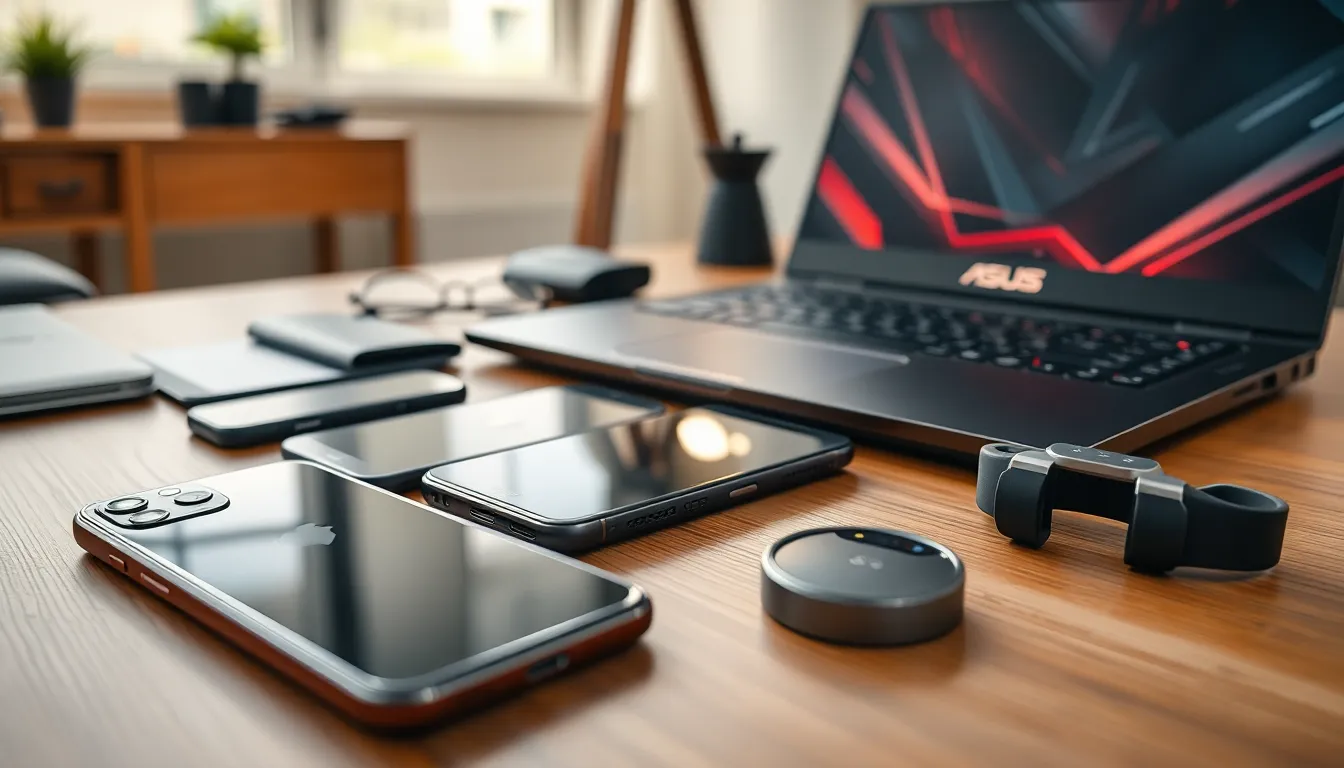Table of Contents
ToggleIn a world where tech gear evolves faster than a cat video goes viral, staying updated can feel like a full-time job. Whether it’s the latest smartphone or that gadget promising to revolutionize your morning coffee routine, the choices are endless—and overwhelming. Fear not, tech enthusiasts!
This guide dives into the nitty-gritty of tech gear reviews, cutting through the jargon and hype. It’s all about helping you find the perfect device without losing your sanity—or your wallet. So grab your favorite snack, kick back, and get ready to discover what’s worth your hard-earned cash and what’s just a shiny mirage in the tech desert.
Top Tech Gear Reviews of the Year
Tech gear continues to evolve, offering an array of devices that cater to various needs. Here are standout reviews for the year across key categories.
Smartphones
Smartphones dominate the tech landscape, with flagship models boasting advanced features. The latest iPhone offers an exceptional camera system and seamless integration with Apple’s ecosystem. Samsung’s Galaxy series impresses with its vibrant displays and robust performance. Google Pixel smartphones excel in photography, providing AI-enhanced images. Budget options, like the Motorola Moto G series, deliver reliable performance without breaking the bank. Overall, consumers benefit from diverse options that suit various preferences and budgets.
Laptops
Laptops remain essential for productivity and leisure. The MacBook Air continues to impress with its lightweight design and impressive battery life. Dell’s XPS line combines premium materials with high-performance specs. For gaming, ASUS ROG laptops offer powerful graphics and refresh rates tailored for gamers. Lenovo’s ThinkPad series stands out for business users due to its durability and excellent keyboard experience. Several affordable Chromebooks also prove practical for casual users, striking a balance between price and performance across the market.
Wearable Tech
Wearable technology has changed how individuals track health and fitness. The Apple Watch Series boasts advanced health monitoring features, including ECG and blood oxygen tracking. Fitbit devices cater to fitness enthusiasts with active tracking and goal-setting capabilities. Garmin smartwatches focus on outdoor performance, appealing to adventurers with GPS and navigation tools. Smart glasses, like Ray-Ban Stories, merge style with tech, allowing users to capture moments hands-free. Overall, wearables enhance daily life by promoting health awareness and connectivity.
In-Depth Product Comparisons

Analyzing tech gear through detailed comparisons helps clarify choices for consumers. Focusing on features and prices provides a comprehensive view of what products offer.
Feature Comparison
Understanding product features reveals how tech gear caters to varied needs. The latest iPhone boasts an advanced camera system, while the Samsung Galaxy series excels in display quality. Google Pixel enhances photography with computational techniques. In the laptop arena, the MacBook Air offers portability, while Dell’s XPS line is known for its vibrant display and powerful performance. ASUS ROG gaming laptops cater to gamers with high-refresh-rate screens and powerful GPUs. Wearable technology includes the Apple Watch Series with seamless app integration and Garmin smartwatches with exceptional battery life. Each of these products shines in specific areas, ensuring consumers find what fits their requirements best.
Price Comparison
Pricing often influences purchasing decisions for tech gear. Flagship smartphones like the latest iPhone start around $999, with the Samsung Galaxy series following closely behind. Budget-friendly options like the Motorola Moto G series typically range from $200 to $300, providing solid performance without breaking the bank. In the laptop segment, MacBook Air prices begin at $999, while Dell’s XPS starts around $1,199. ASUS ROG gaming laptops can exceed $1,500, appealing to serious gamers. Wearables also show price variance, with Apple Watch Series starting at $399, Garmin smartwatches ranging from $200 to $600, and Fitbit offering models from $150 to $300. Balancing features with price helps consumers identify the best value choices in tech gear.
Expert Tips for Choosing Tech Gear
Choosing the right tech gear involves understanding personal requirements and staying informed about brands and models. This ensures informed decisions lead to satisfactory purchases.
Identifying Your Needs
Understanding personal needs is vital before selecting tech gear. Assessing usage scenarios helps establish priorities. Consider factors like specific tasks, frequency of use, and desired features. For instance, a professional photographer may require a smartphone with advanced camera capabilities, while casual users might prioritize battery life and ease of use. Establishing a budget also aids in narrowing down choices. Identifying must-have features versus nice-to-haves strengthens decision-making.
Researching Brands and Models
Examining various brands and models allows for informed selections. Each brand offers unique benefits and features, impacting overall performance. Reading expert reviews, user opinions, and comparison guides provides insight into reliability and functionality. Well-known brands such as Apple, Samsung, and Dell frequently deliver quality assurance. For budget-conscious consumers, exploring lesser-known brands might reveal impressive alternatives. Keeping track of product release cycles enhances awareness of the latest innovations. Staying updated on tech trends helps in discovering the best possible options.
Future Trends in Tech Gear
Emerging tech gear trends showcase significant advancements across various categories. Smart devices are increasingly incorporating artificial intelligence, enhancing user experiences with adaptive features. Smartphones now sport foldable designs, offering users innovative ways to interact with their devices.
Wearable technology integrates seamlessly with health monitoring applications, significantly improving fitness tracking and personal wellness. Companies focus on lightweight materials, making devices easier to carry without sacrificing durability.
Wireless technology continues to evolve, with advancements in Bluetooth and Wi-Fi standards leading to faster data transfer and more reliable connections. High-quality audio products are now equipped with noise cancellation, allowing users to enjoy music without distractions.
Battery technology is a crucial area of development, with longer-lasting and faster-charging options becoming standard in many devices. Consumers increasingly demand eco-friendly products, prompting manufacturers to adopt sustainable practices in their production processes.
Augmented and virtual reality are gaining traction, enhancing gaming and training experiences with immersive environments. Devices that support these technologies are becoming more affordable, making them accessible to a broader audience.
As tech enthusiasts look ahead, the integration of 5G technology promises to revolutionize connectivity, enabling faster speeds and improved performance for smart devices. With these trends shaping the future, consumers will continue to see remarkable innovations that meet their evolving needs.
Navigating the world of tech gear doesn’t have to be overwhelming. With a clear understanding of personal needs and priorities, consumers can make informed choices that fit their lifestyles and budgets. The reviews and comparisons highlighted in the guide serve as a valuable resource for identifying standout products across various categories.
As technology continues to evolve, staying informed about the latest trends and innovations will empower users to select gear that not only meets their current needs but also adapts to future demands. Embracing this knowledge will enhance their tech experience and ensure they get the best value for their investments.





